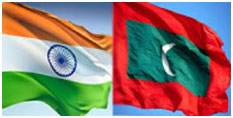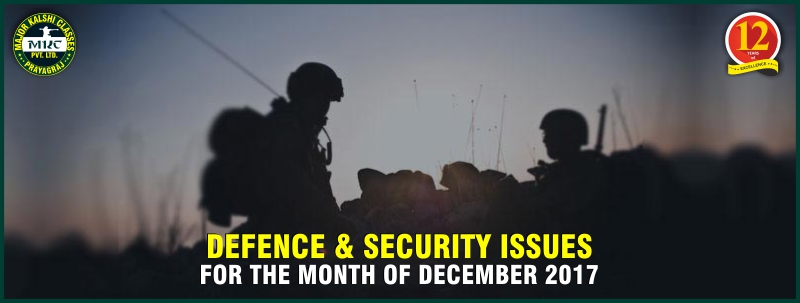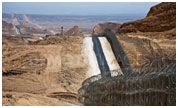DEFENCE & SECURITY ISSUES FOR THE MONTH OF DECEMBER 2017
(COMPREHENSIVE CURRENT AFFAIRS FOR CDS/AFCAT/NDA OTHER DEFENCE EXAMINATIONS)
Defence examinations like CDS/AFCAT/NDA is scheduled very soon. Previous trend of these examinations shows that current affairs carries due weightage and directly or indirectly gets associated with other subjects also. Current affairs plays very important role in these examinations. In most of these examinations candidates can find 20 to 30 questions which definitely plays very important role. Major Kalshi Classes is providing you collection of Defence & Security issues which are strategic in nature and affects India somewhere.
INDIAN NAVY GETS ACCESS TO SINGAPORE’S CHANGI NAVAL BASE
- In a strategic move that is likely to irk China, India and Singapore have signed a bilateral agreement that will allow Indian Navy ships logistical support, including refuelling, at Singapore’s Changi naval base located near the disputed South China Sea.
![Current Affairs]()
WHAT DOES THIS MEAN FOR INDIA?
Table of Contents
- This means that Indian Navy ships sailing through the disputed South China Sea or in the eastern waters of the Andaman Sea will be able to refuel, restock and, if needed, rearm at Singapore’s latest naval base before continuing their mission. This means the Indian Navy will be able to directly engage Singaporean authorities when they need to use their facilities unlike the present structure where a request has to be sourced from the Indian Navy to the government of Singapore through the Defence Ministry and then the External Affairs Ministry, a process that can take weeks if political clearances need to be obtained in Singapore.
SIGNIFICANCE OF THIS MOVE:
- The naval logistics agreement is the first for India with a country located east of Malacca. The nearest Indian base is in the Andaman and Nicobar Islands. The Changi base will therefore enhance the navy’s operational reach. The naval base also plays a prominent role in the protection of naval vessels, repair facilities, supplies, administration and logistics support.
STRATEGIC SIGNIFICANCE OF SINGAPORE:
- Singapore is strategically situated on the major international sea routes – the Straits of Singapore and Malacca – and connects the Pacific and Indian Oceans making it economically important.
- The country acts as the centre for international communications, transportations and trade to Southeast Asia. It works with neighboring littoral states for safety, stability, regional peace and navigational freedom.
CLEAN SEA-2017
- The Regional Level Marine Oil Pollution Response Exercise titled ‘Clean Sea – 2017’, was recently conducted at sea off Port Blair.
![Current affairs]()
- THE OBJECTIVE OF THE EXERCISE was to ascertain preparedness of the Indian Coast Guard, resource agencies and other stakeholders in responding to a major oil spill in line with the provisions of NOS-DCP (National Oil Spill Disaster Contingency Plan).
BACKGROUND:
- Indian Coast Guard is responsible for marine environment protection in the maritime zones of India and is the coordinating authority for response to oil spills in Indian waters. The Force has drawn up a National Oil Spill Disaster Contingency Plan (NOSDCP) and has established three pollution response centres at Mumbai, Chennai and Port Blair.
NATIONAL OIL SPILL DISASTER CONTINGENCY PLAN
- India promulgated National oil spill Disaster contingency plan (NOS-DCP) in the year 1996. Coast guard was designated as central coordination authority.
THE OBJECTIVES OF THE PLAN ARE:
- To develop appropriate and effective systems for the detection and reporting of spillage of oil.
- To ensure prompt response to prevent, control, and combat oil pollution.
- To ensure that adequate protection is provided to the public health and welfare, and the marine environment.
- To ensure that appropriate response techniques are employed to prevent, control, and combat oil pollution, and dispose off recovered material in an environmentally accepted manner.
- To ensure that complete and accurate records are maintained of all expenditure to facilitate cost of recovery.
52nd Raising Day of BSF observed
- The Border Security Force (BSF), the biggest border guarding force in the world celebrated its 52nd Anniversary of Raising Day. Various cultural programmes were organized for BSF veterans and personnel during the Raising Day celebrations.
Border Security Force (BSF)
- BSF is the sentinels of Indian borders with Pakistan and Bangladesh. It came into existence on 1st December, 1965. It was created by merging various State Armed Police Battalions for achieving better coordinated synergy between border guarding functions in peace time and fighting war during eventuality on both Western and Eastern fronts.
- BSF is deployed on Indo-Pakistan International Border, Indo-Bangladesh International Border, Line of Control (LoC) along with Indian Army and in Anti- Naxal Operations. Since its inception, BSF has proven its credentials during various counter insurgency and anti-militancy operations, internal security duties, natural calamities etc.
India re-elected to International Maritime Organization Council
- India was re-elected to Council of the International Maritime Organization (IMO) at an assembly of body at its headquarters in London.
- India was elected under category B that represents nations with largest interests in international sea borne trade. It secured second-highest 144 number of votes from member-countries, just after Germany’s 146.
International Maritime Organization (IMO)
- IMO is a specialized agency of the United Nations responsible for regulating shipping. It was established in 1948 in Geneva and came into force in 1959. Its headquarters are in London, United Kingdom. IMO has 171 member states and 3 associate members. India was one of earliest members of the IMO.
- India has been one of earliest members of IMO, having ratified its convention and joined it as a member-state in 1959.
Vigilant Ace: South Korea, US launch largest air exercise
- South Korea and United States have launched Vigilant Ace, their largest-ever joint aerial drills. The exercise comes after North Korea tested Hwasong-15, its most advanced and powerful Inter Continental Ballistic Missile (ICBM) as part of its weapon programme.
Vigilant Ace
- Vigilant Ace is annual US-South Korean drill designed to enhance their readiness and operational capability and to ensure peace and security on Korean peninsula. More than 12,000 service members from US will join airmen from South Korea in air combat exercise.
- The fighters will fly to Korean Peninsula from Kadena Air Base on Okinawa, Japan.
Background
- The isolated and impoverished North Korea has staged six increasingly powerful atomic tests since 2006 – most recently in September 2017.
- It nuclear and missile programmes have made significant progress under leader Kim Jong-Un, who has overseen four nuclear tests and dozens of missile launches since taking power in 2011.
- Recently in November 2017, North Korea had claimed that Hwasong 15 ICBM is capable of delivering a “super-large” nuclear warhead anywhere in US mainland.
AKASH MISSILE
- Supersonic surface-to-air missile- Akash with indigenous radio frequency seeker was recently test fired from a test range in Odisha. With the successful test firing, India has achieved the capability of making any type of surface to air missile.
![Current Affairs]()
WHAT YOU NEED TO KNOW ABOUT THE MISSILE?
- Akash, the supersonic missile, is the first surface-to-air missile with indigenous seeker to be test fired and is being inducted into the Army as short range surface to air missile.
- It has a strike range of about 25 km and carries a 55- kg fragmentation warhead that is triggered by proximity fuse.
- It is an all-weather area air defence weapon system for defending vulnerable areas against medium range air targets penetrating from low, medium and high altitudes.
- Developed by the Defence Research and Development Organization (DRDO), the Akash missile system has the capability to neutralize aerial targets like fighter jets, cruise missiles and air-to-surface missiles as well as ballistic missiles.
- The system is designed to neutralize multiple aerial targets attacking from several directions simultaneously. The system is autonomous and its operation is fully automated. There is flexibility in deployment.
- It uses state-of-the-art integral ram jet rocket propulsion system and the onboard digital autopilot ensures stability and control. Electro-pneumatic servo actuation system controls cruciform wings for agile response and thermal batteries provide onboard power supply.
OP Sahayam
- It is an Indian Navy exercise for undertaking Search and Rescue (SAR) and providing Humanitarian Assistance and Disaster relief (HADR) material support, over Southeast Arabian Sea and L& M islands in the aftermath of Very Severe Cyclonic Storm ‘OCKHI’.
BORDER PROTECTION GRID (BPG)
![current Affairs]()
- The Union Home Minister recently highlighted the importance of having Border Protection Grid (BPG) in the country. The concept was highlighted during the recently held meeting of the Chief Ministers of the Indo-Bangladesh Border (IBB) States, in Kolkata.
ABOUT BPG:
- Border Protection Grid (BPG) is a multi-pronged and foolproof mechanism to secure border. The grid will comprise of various elements namely physical barriers, non-physical barriers, surveillance system, Intelligence agencies, State Police, BSF and other State and Central agencies.
- BPG will be supervised by a State level Standing Committee under the Chairmanship of respective Chief Secretaries.
NEED FOR BPG:
- Border security is important to facilitate legitimate trade and commerce between the countries. India has friendly relations with Bangladesh and there is a need to facilitate genuine trade and legitimate cross-border movement of people while curbing radicalization, illegal migration, and smuggling of cattle, fake Indian currency notes and drugs etc. BPG will ensure greater help for the States in the overall border security.
- Secure borders are also necessary to prevent entry of illegal migrants some of whom have links with extremist groups for furthering anti-national activities with ulterior motives and posing threat to internal security.
BACKGROUND:
- The Indo-Bangladesh Border covering 5 states of India including Assam, Meghalaya, Mizoram, Tripura and West Bengal is 4096 km long. So far in 3006 km border security infrastructure of fence, roads, floodlights and border out posts (BOPs) are in place and works in the remaining 1090 km are yet to be started. Out of this, 684 km will be secured with fence and the related infrastructure, and the balance 406 km with the non-physical barriers. Although bulk of the infrastructure is in place or under construction, construction in some parts is yet to commence mainly due to land acquisition issues.
SCORPENE-CLASS SUBMARINE KALVARI

- India’s first modern conventional submarine, INS Kalvari, has been commissioned into Navy’s fleet.
INS Kalvari- key facts:
- The diesel-electric submarine is designed by French naval defence and energy company DCNS. The submarine is named after the dreaded tiger shark, a deadly deep sea predator of the Indian Ocean.
- The submarine boasts of superior stealth features such as advanced acoustic silencing techniques, low radiated noise levels, hydro-dynamically optimised shape and the ability to launch a crippling attack on the enemy using precision-guided weapons.
- The submarine, which has a speed of 20 knots, is equipped with sea-skimming SM-39 Exocet missiles and heavy-weight wire-guided surface and underwater target torpedoes.
‘EKUVERIN’

WHAT IS IT?
- It is a joint military exercise between India and Maldives. The eighth edition of the exercise is being held in Belagavi, Karnataka.
KEY FACTS:
- The bilateral annual exercise is a 14-day joint military training between the Indian Army and the Maldives National Defence Force (MNDF), which is held alternatively in India and Maldives since 2009. The seventh edition of the exercise was held at Kadhdhoo, Lammu Atoll, Maldives in December, 2016.
- The focus of the exercise is to acquaint both armies with each other’s operating procedures in the backdrop of a counter-insurgency or counter-terrorist operations in an urban or semi-urban environment under the United Nations (UN) Charter, with an overall aim to enhance interoperability between the two armies.
- ‘Ekuverin’ means ‘friends’ in the Maldivian language.
HAMESHA VIJAYEE: Southern Command conducts major exercise in Rajasthan
- The Southern Command of Indian Army conducted major army exercise called ‘HameshaVijayee’ in deserts of Rajasthan from December 16 to 22, 2017.
- The purpose of the exercise was to evaluate capability of armed forces to strike deep into enemy territory in an integrated air-land battle.
- The Southern Command (hearquaters Pune) undertakes such exercises at regular intervals to ensure high degree of battle readiness as well as validation of operational plans using modern weapons and equipment.
- The ‘HameshaVijayee’ exercise was conducted in battle like conditions that aimed at fine tuning surveillance and destruction mechanisms to support precision strikes and manoeuvres by network enabled forces.
- The exercise showcased high degree of synergy between Indian Army and Air Force along with new generation aviation assets of army which were reviewed to obtain inputs for further refinement of operational procedures.
- Besides conventional warfare, troops also rehearsed to operate in back drop of chemical and nuclear contingencies.
Naseem-Al-Bahr 2017: India, Oman conducts naval exercise
- The 11th edition of Naseem-Al-Bahr (Sea Breeze) 2017 Naval exercise between India and Oman was held at Said Bin Sultan Naval Base, Wudam in Oman.
- The year marks 24 years of Indian Navy-Royal Navy of Oman bilateral exercises that has been a biennial feature since 1993.
- The Indian Navy had deployed two naval ships – INS Trikand and INS Teg in this edition of bilateral exercise for the harbour phase. In sea phase of the exercise, Indian Navy ships along with four Royal Navy of Oman ships Al Mubashir, Al Rasikh, Khassab and Al Bushra had sailed. Ffor the first time, an Indian Navy had deployed submarine as well as the versatile P8I, long range maritime aircraft are participating.
Background
- India has ancient maritime tradition and maritime interaction with Oman dates back to over 4000 years BC. Bilateral relations between both countries were formally established with signing of 1953 Indo-Oman Treaty of friendship, Navigation and Commerce. It was first between India and Arab country.
- Since then, bilateral naval exercises have contributed to strengthening of bilateral ties between both countries. The first exercise Indian Navy with Royal Navy of Oman was conducted in 1993.
ICGS Sujay: Offshore Patrol Vessel commissioned into by Indian Coast Guard
- An Offshore Patrol Vessel (OPV) named ICGS Sujay was recently commissioned into Indian Coast Guard (ICG). It is sixth and last in the series of six 105m OPV built indigenously by Goa Shipyard Limited for ICG.
- Presently, ICG has fleet of 134 ships and boats and 66 ships and boats are at various stages of construction at different shipyards in India.
ICGS Sujay
- ICGS Sujay (meaning Great Victory) will based at Paradip, Odisha under operational and administrative control of Commander Coast Guard Region (North-East). It will be deployed extensively for EEZ surveillance and other duties as enshrined in Coast Guard Charter, to safeguard maritime interest of India.
- It can also carry pollution response equipment to contain oil spill at sea. It has latest and modern equipment and systems that provides ship capability to perform role of Command platform to accomplish all ICG charter of duties.
AG600: World’s largest amphibious aircraft takes off
- China’s home-grown AG600, also known as ‘Kunlong’, the world’s largest amphibious aircraft took off took off from the southern city of Zhuhai and landed after roughly an hour-long flight.
- Its successful maiden flight makes China among the world’s few countries capable of developing a large amphibious aircraft. It also further strengthen China’s rapidly modernizing military.
- The AG600 amphibious aircraft can land and take off from water. It has wingspan of 38.8 meters. It is powered by four turboprop engines. It has been designed and built by China’s state-owned manufacturer Aviation Industry Corp of China. It is capable of carrying 50 people and can stay airborne for 12 hours. It has operational range of 4,500-km.
- The aircraft has military applications but will be also used for firefighting and marine rescue. Its flight capabilities put all of China’s artificial island-building projects in disputed South China Sea (SCS) well within its range.
‘Mission Seven Summits’
- After scaling of Mt Everest in 2005, IAF launched a unique and unprecedented series of mountaineering expedition ‘Mission Seven Summits’ with an aim to fly the tricolour and the IAF flag on the highest peaks in every continent. With this, the IAF has become the first organisation in India to achieve this unique feat.
- The highest peak on each continent – Asia Mt. Everest, Australia Mt. Kosciuszko, South America Mt. Aconcagua, Antarctica Mt. Vinson Massif, North America Mt. Denali, Europe Mt. Elbrus and Africa Mt. Kilimanjaro – are part of Misson7Summit.
You may land up with many questions from this collection, so it is must for a defence aspirant to go through these questions. Candidates can also get detailed analysis on these issues in the official current affairs magazine of Major Kalshi Classes.












